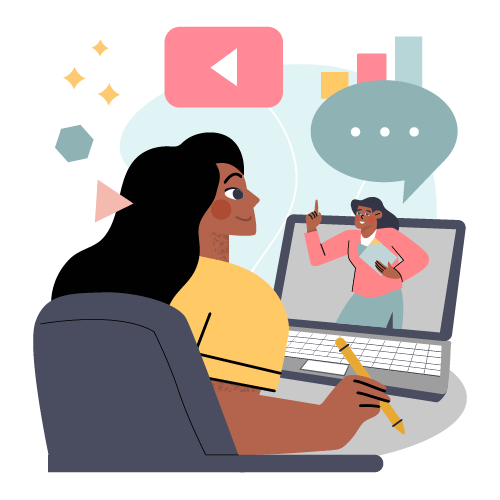Have you ever had to design an online course without much information about the audience? If so, we feel you.
We know how challenging that situation is. We also know how hard it is to teach a topic in a short period of time. Or how complex it is to revamp an existing online course without changing its original structure. However, that’s especially common in the corporate world. As is the need to create a single course that satisfies audiences with varied learning styles and training needs.
Trying to anticipate the unique needs of every audience member who may end up taking a course, when learners will be eager to deepen their knowledge, or when they’ll struggle to achieve particular learning outcomes and need additional assistance can be challenging.. But you can prepare for any of these scenarios! And this article will help you understand why supplemental learning is the solution.
Let’s begin by exploring the definition of supplemental learning.
Supplemental learning as a method of promoting learning
Supplemental learning is the use of optional training resources that complement the main resources of a course. And those optional training materials include:
- Books and eBooks
- Articles, guides, and tutorials
- Podcasts and videos
- Slide decks and lesson notes
- Workbooks, checklists, templates, and job aids
Also, it’s typical for designers of eLearning and blended learning experiences to include supplemental resources in their solutions. Because appending those materials to a course promotes learning and engages learners in distinct ways.
Benefits of supplemental learning
This is how supplemental resources encourage learning:
Expands the course’s original structure
If you’re improving an existing online course, supplemental resources don’t interfere with its effectiveness. They preserve the cohesion of the course’s structure while creating opportunities to learn further.
This means optional training materials maintain the course’s outcomes, modules, units, lessons, activities, and assessments. But it also means that supplemental learning allows your learners to gain more knowledge and build more skills.
Keep in mind, though, that the course’s structure plays a significant role in the processes of training and learning. Because organizing the components of a course in a sequence and ensuring they make sense for the topic and difficulty level—individually and all together—makes the course effective.
Enables the audience’s variety
Supplemental learning comes in handy when you’re enhancing an existing online course, and:
- You don’t know much about the learners you’re targeting;
- But you can’t change the current course.
This leaves you with supplemental resources as your only option as they allow you to:
- Address diversified learning styles
- Fulfill varied training needs, whether those needs depend on the learners’
- Job or company
- Performance in previous courses
- Prior knowledge of the course’s topic
Maximizes the learning time
You might need to keep your audience learning longer for two reasons: eagerness to learn and learning difficulties. Let’s analyze each case.
Your learners want to voluntarily explore a certain topic that the online course covers—not because they need to do it to get a course certificate, but because they’re:
- Fond of the topic
- Curious to know more details
- Intrigued by specific aspects
- Fast learners who reached the course’s outcomes quicker than others
- Lifelong learners, and your course is the perfect excuse for additional learning
You want to be ready to support learners who might face difficulties in their learning process. Because let’s face it, whatever effort you put into developing an online course, there’s always going to be a learner who:
- Is new to the topic—yet enrolled in a course at an intermediate or advanced level
- Missed a part of the course—because they had to attend an overlapping meeting or were absent from work
- Failed to understand a fundamental concept or idea—which disrupted the flow of their learning experience, derailing the process of acquiring new knowledge and growing new skills
Triggers innovation
Is your online course’s duration limited because your company urgently needs to teach its employees about the topic?
For instance, that might be the case with a new technology that just became available on the market. And unless your staff gets acquainted with it quickly, your organization might risk a competitor using that technology to answer a market need faster.
Fortunately, supplemental learning can help you shrink your course’s duration. And by doing so, you kickstart the learning and innovation process.
Tests learners’ knowledge and skills
Supplemental learning isn’t comprised of training materials only! It also includes complementary activities, such as optional quizzes.
And learners seek those activities for the same reasons they seek supplemental resources. But you can also add extra activities to the course to test your audience’s knowledge and skills. The only catch is that they’re not mandatory, so you might not get the input you’d like.
Raises the course’s applicability
When you don’t know much about your learners, giving examples of how the course’s topic fits multiple lines of business is essential. It demonstrates the usefulness of the topic to a broad audience, just in case you face one. But you usually know some details about your audience, so you can customize examples for them.
Either way, supplemental learning can help you with an online course’s applicability. Extend your course with resources that show how the new knowledge and skills could apply to different scenarios depending on:
- The learner’s company—its size or location
- The department, team, or project
- The industry in which the organization operates
Points to more courses
If you want to strategically share materials at a higher level of difficulty, supplemental learning is a solution. For instance, if your online course is at the intermediate level, share a few supplemental resources at the advanced level.
That’ll pique your learners’ curiosity about upcoming courses and keep them engaged in the training program. Just make sure the majority of the optional resources you share are at the same level of difficulty as the current course.
What to do next?
Now you know how optional training resources inspire learning and keep motivation levels high. It’s time to discover the learning solutions we can supply for supplemental learning!






